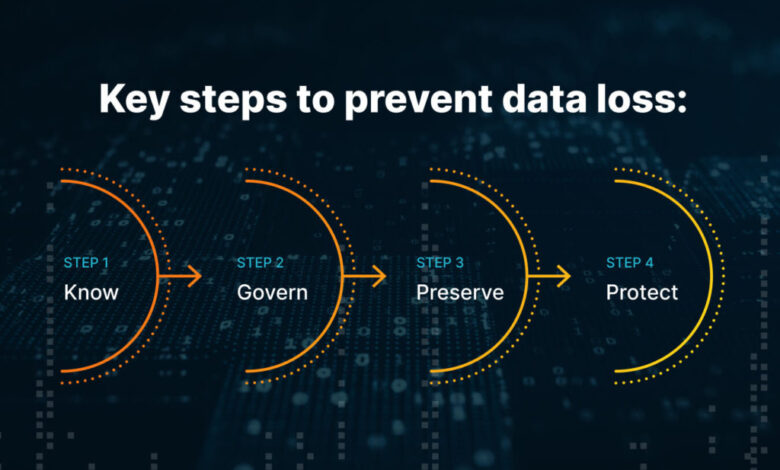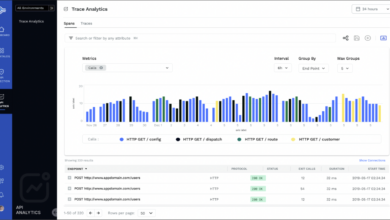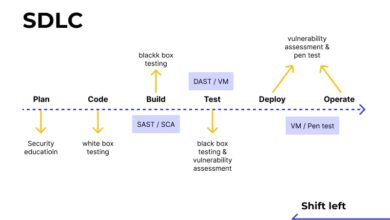
Data Loss Prevention in an API-Driven World
Data loss prevention in an api driven world – Data loss prevention in an API-driven world is more critical than ever. APIs, while incredibly powerful tools for connecting applications and sharing data, also introduce new vulnerabilities. This post dives into the challenges of securing APIs and preventing data breaches, exploring practical techniques, best practices, and the importance of proactive threat modeling and robust incident response plans. We’ll cover everything from securing authentication and authorization to implementing data masking and encryption, and how proper API documentation plays a vital role in maintaining data integrity.
The increasing reliance on APIs means data is constantly moving between systems, making it crucial to understand the unique security risks involved. We’ll explore how to address these risks, ensuring your organization remains compliant with regulations like GDPR and CCPA, while safeguarding sensitive user information. This isn’t just about technical solutions; it’s about building a culture of security throughout the entire API lifecycle.
API Security Vulnerabilities and Data Loss

APIs, while crucial for modern application development, present significant security challenges. Their interconnected nature and reliance on data exchange make them prime targets for attackers seeking to compromise sensitive information. Understanding the vulnerabilities and implementing robust security measures are paramount to prevent data loss.
Common API Vulnerabilities Leading to Data Breaches
Several common vulnerabilities can lead to API-related data breaches. These include broken authentication, lack of authorization, injection flaws (SQL injection, Cross-Site Scripting), excessive data exposure, and insecure design. Broken authentication, for example, might allow unauthorized access to sensitive data simply by exploiting a weakness in the login process. Injection flaws can allow attackers to manipulate API requests to execute malicious code or access unauthorized data.
Excessive data exposure occurs when an API returns more information than necessary, potentially revealing sensitive details that could be exploited. Insecure design encompasses broader architectural weaknesses that can be leveraged by attackers.
Impact of Insecure API Authentication and Authorization on Data Loss Prevention
Insecure API authentication and authorization are major contributors to data loss. Weak authentication mechanisms, such as easily guessable passwords or lack of multi-factor authentication (MFA), allow unauthorized access. Insufficient authorization controls permit users to access resources beyond their permitted privileges. For example, a poorly implemented authorization scheme might allow a regular user to access and modify administrative data, leading to significant data breaches or corruption.
Robust authentication and authorization are fundamental to preventing unauthorized access and data exfiltration.
The Role of Input Validation and Sanitization in Preventing Data Loss Through APIs
Input validation and sanitization are crucial for preventing data loss through APIs. Failing to validate and sanitize user inputs leaves the API vulnerable to injection attacks. Attackers can inject malicious code or data into API requests, potentially manipulating database queries, executing arbitrary code, or accessing sensitive information. Thorough input validation checks the data type, format, length, and range of input parameters, ensuring they conform to expected values.
Sanitization removes or neutralizes potentially harmful characters or data before it is processed by the API, preventing injection attacks. For example, a robust input validation system might reject any input containing SQL s, thus preventing SQL injection attacks.
A Secure API Authentication and Authorization Strategy
A secure API authentication and authorization strategy should incorporate several key elements. Firstly, strong authentication mechanisms such as OAuth 2.0 or OpenID Connect should be implemented. These protocols provide secure and standardized ways for users and applications to authenticate and authorize access to APIs. Secondly, fine-grained authorization controls should be implemented to ensure that users only have access to the resources they are entitled to.
This might involve using role-based access control (RBAC) or attribute-based access control (ABAC). Finally, regular security audits and penetration testing should be conducted to identify and address vulnerabilities before they can be exploited. Implementing rate limiting and input validation also significantly reduces the risk of brute force attacks and data injection.
Comparison of API Security Best Practices
| Security Best Practice | Description | Effectiveness in Preventing Data Loss | Implementation Complexity |
|---|---|---|---|
| Input Validation & Sanitization | Validating and sanitizing all user inputs to prevent injection attacks. | High | Medium |
| OAuth 2.0/OpenID Connect | Using industry-standard protocols for secure authentication and authorization. | High | High |
| Rate Limiting | Limiting the number of requests from a single IP address or user. | Medium | Low |
| RBAC/ABAC | Implementing role-based or attribute-based access control to restrict access to resources. | High | Medium-High |
Data Loss Prevention Techniques in API-Driven Architectures
APIs are the backbone of modern applications, facilitating seamless data exchange. However, this interconnectedness also introduces significant security challenges, particularly concerning data loss prevention (DLP). Robust DLP strategies are crucial to safeguarding sensitive information transmitted through APIs. This section explores various techniques and best practices for implementing effective API-level DLP.
Data Masking and Encryption in API Responses
Data masking and encryption are fundamental DLP techniques for protecting sensitive data within API responses. Data masking involves replacing sensitive data elements with non-sensitive substitutes, while retaining the data structure and format. For example, a credit card number might be masked as “XXXXXXXXXXXX1234”, revealing only the last four digits. Encryption, on the other hand, transforms data into an unreadable format, requiring a decryption key for access.
Both techniques significantly reduce the risk of data exposure in case of unauthorized access or breaches. Implementing these requires careful consideration of the specific data sensitivity levels and the choice of appropriate masking and encryption algorithms. Symmetric encryption, like AES, is often used for its speed, while asymmetric encryption, like RSA, is preferred for key management and secure communication.
API Gateways and DLP Policy Enforcement
API gateways act as central points of control for all API traffic. They are instrumental in enforcing DLP policies by inspecting and modifying API requests and responses. A gateway can implement various security checks, including data validation, access control, and data transformation. For instance, an API gateway can be configured to automatically mask sensitive data fields in responses before they are sent to clients.
Popular API gateways like Apigee, Kong, and AWS API Gateway offer built-in functionalities for DLP, including data masking, encryption, and rate limiting. These features allow for centralized management and enforcement of security policies across all APIs. Furthermore, integration with other security tools, such as Web Application Firewalls (WAFs), can enhance the overall security posture.
Logging and Monitoring API Activity for Data Breach Detection
Comprehensive logging and monitoring are essential for detecting and responding to potential data breaches. API gateways and other security tools can generate detailed logs that capture all API activity, including requests, responses, and errors. These logs should include timestamps, user IDs, IP addresses, and the data exchanged. By analyzing these logs, security teams can identify suspicious patterns, such as unauthorized access attempts or unusual data access volumes.
Real-time monitoring tools can provide immediate alerts for potential breaches, enabling timely responses to mitigate the impact. Sophisticated analytics platforms can be employed to detect anomalies and predict potential threats. For example, an unexpected spike in API calls accessing sensitive data might indicate a potential breach.
Step-by-Step Guide for Implementing API-Level Data Loss Prevention
Implementing effective API-level DLP requires a systematic approach.
- Assess Data Sensitivity: Identify and classify all sensitive data elements exchanged through APIs. This forms the basis for defining appropriate DLP policies.
- Choose DLP Techniques: Select appropriate DLP techniques based on the sensitivity of the data. This may involve a combination of data masking, encryption, and access control measures.
- Implement Data Masking and Encryption: Integrate data masking and encryption functionalities into API responses using appropriate libraries and tools. Consider using industry-standard algorithms and key management practices.
- Configure API Gateway: Configure the API gateway to enforce DLP policies, including data validation, access control, and data transformation rules. Leverage the gateway’s built-in functionalities or integrate with external DLP tools.
- Implement Logging and Monitoring: Configure detailed logging and monitoring of API activity. Integrate with security information and event management (SIEM) systems for centralized log analysis and threat detection.
- Regularly Review and Update Policies: DLP policies should be regularly reviewed and updated to adapt to evolving threats and data sensitivity requirements.
Data Governance and Compliance in API Environments
The rise of API-driven architectures has dramatically reshaped how businesses handle data, creating both exciting opportunities and significant challenges. While APIs offer increased agility and efficiency, they also introduce complexities in maintaining data governance and ensuring compliance with increasingly stringent regulations. Understanding these complexities and implementing robust strategies is crucial for any organization leveraging APIs to manage sensitive data.The proliferation of APIs increases the attack surface and expands the potential for data breaches.
Furthermore, the distributed nature of API-based systems makes tracking and controlling data flow incredibly difficult. This necessitates a proactive approach to data governance that goes beyond traditional methods.
Challenges of Maintaining Data Governance and Compliance in API Environments
Maintaining data governance and compliance in an API-driven world presents unique challenges. The decentralized nature of APIs, with data often flowing across multiple systems and organizations, makes it difficult to track data usage and enforce consistent policies. Furthermore, the rapid pace of API development and deployment can outpace the ability of organizations to implement and maintain adequate controls.
Legacy systems integrated via APIs may lack the necessary security and auditing capabilities, posing further risks. Finally, understanding and adhering to a multitude of evolving global data privacy regulations adds a significant layer of complexity.
Impact of APIs on Data Sovereignty and Regulatory Compliance
APIs significantly impact data sovereignty and regulatory compliance. Data transmitted via APIs may cross international borders, potentially violating data sovereignty laws that restrict the transfer of personal data outside specific jurisdictions. Regulations like GDPR (General Data Protection Regulation) and CCPA (California Consumer Privacy Act) impose strict requirements on how personal data is collected, processed, and protected, regardless of where it’s stored or processed.
APIs that fail to adhere to these regulations risk substantial fines and reputational damage. For example, an API inadvertently sharing personally identifiable information (PII) with a third-party service in a country without adequate data protection laws would be a direct violation of GDPR.
Methods for Ensuring Data Privacy and Security within API Integrations, Data loss prevention in an api driven world
Ensuring data privacy and security within API integrations requires a multi-layered approach. This includes implementing robust authentication and authorization mechanisms to control access to APIs and the data they expose. Data encryption, both in transit and at rest, is essential to protect sensitive information. Regular security assessments and penetration testing can identify vulnerabilities before they are exploited.
Implementing data masking or tokenization can further reduce the risk of data breaches by replacing sensitive data with non-sensitive substitutes. Finally, thorough logging and monitoring of API activity can help detect and respond to suspicious behavior. A well-defined data lifecycle management strategy should include clear data retention policies and procedures for secure data disposal.
Data Governance Framework for APIs Addressing Data Lifecycle Management
A comprehensive data governance framework for APIs should address the entire data lifecycle, from creation to disposal. This includes defining clear data ownership and responsibility, establishing data quality standards, and implementing data security policies. The framework should also Artikel procedures for data access requests, data breaches, and data retention. Regular audits and reviews are essential to ensure the framework’s effectiveness.
A key element is the creation of a centralized inventory of all APIs, including details about the data they handle and the security controls in place. This inventory serves as a crucial tool for risk management and compliance monitoring. Consider using a data catalog and governance platform to streamline the management of this inventory.
Compliance Requirements Checklist for APIs Handling Sensitive Data
Before deploying an API that handles sensitive data, a thorough compliance checklist should be completed. This checklist should cover aspects such as:
- Data inventory and classification: Identifying all sensitive data processed by the API and classifying it according to sensitivity levels.
- Access control: Implementing robust authentication and authorization mechanisms to restrict access to sensitive data based on roles and permissions.
- Data encryption: Ensuring data is encrypted both in transit and at rest.
- Data masking/tokenization: Employing techniques to protect sensitive data by replacing it with non-sensitive substitutes.
- Logging and monitoring: Implementing comprehensive logging and monitoring to detect and respond to suspicious activity.
- Data retention policies: Establishing clear policies for how long sensitive data is retained and how it is securely disposed of.
- Compliance with relevant regulations: Ensuring the API adheres to all applicable data privacy and security regulations (e.g., GDPR, CCPA, HIPAA).
- Third-party risk assessment: Assessing the security practices of any third-party services integrated with the API.
- Regular security assessments and penetration testing: Conducting regular security assessments and penetration testing to identify and address vulnerabilities.
- Incident response plan: Developing a comprehensive incident response plan to address data breaches and other security incidents.
Threat Modeling for API-Based Data Protection: Data Loss Prevention In An Api Driven World
Protecting data in an API-driven world requires a proactive approach, and threat modeling is a cornerstone of that strategy. It’s not enough to simply build APIs; we need to anticipate how malicious actors might try to exploit them and steal sensitive information. Threat modeling helps us identify vulnerabilities before they can be exploited, leading to more secure and resilient systems.Threat modeling methodologies provide a structured way to analyze potential threats and vulnerabilities.
By systematically examining the API’s design, functionality, and interactions with other systems, we can identify potential attack vectors and develop mitigation strategies. This proactive approach is far more effective and cost-efficient than reacting to breaches after they occur.
Threat Modeling Methodologies for API Security
Several established methodologies can be used for threat modeling APIs, including STRIDE (Spoofing, Tampering, Repudiation, Information disclosure, Denial of service, Elevation of privilege), PASTA (Process for Attack Simulation and Threat Analysis), and DREAD (Damage Potential, Reproducibility, Exploitability, Affected Users, Discoverability). Each methodology offers a slightly different approach, but the core principle remains the same: systematically identifying potential threats and vulnerabilities.
Choosing the right methodology often depends on the complexity of the API and the resources available. For instance, a simpler API might benefit from a less complex methodology like STRIDE, while a more complex system might require a more detailed approach like PASTA.
The Role of Penetration Testing and Vulnerability Assessments
Threat modeling provides a theoretical framework, but penetration testing and vulnerability assessments provide practical validation. Penetration testing simulates real-world attacks to identify exploitable vulnerabilities, while vulnerability assessments use automated tools to scan for known weaknesses. These two approaches complement each other, providing a comprehensive view of the API’s security posture. Penetration testing often reveals vulnerabilities not uncovered by static analysis, highlighting the importance of a multi-layered security approach.
For example, a penetration test might uncover a flaw in authentication logic that a vulnerability scanner missed, leading to unauthorized access and potential data breaches.
Threat Model for a Specific API Scenario: User Authentication
Let’s consider a simple user authentication API. This API allows users to log in using their username and password.
- Threat: Credential stuffing – attackers using stolen credentials from other websites to attempt logins.
- Vulnerability: Lack of rate limiting or insufficient password complexity requirements.
- Mitigation: Implement rate limiting to prevent brute-force attacks, enforce strong password policies, and potentially utilize multi-factor authentication (MFA).
- Threat: Session hijacking – attackers stealing a user’s session token to impersonate them.
- Vulnerability: Insecure storage or transmission of session tokens (e.g., using HTTP instead of HTTPS).
- Mitigation: Use HTTPS for all API communication, implement secure session management techniques, and regularly rotate session tokens.
- Threat: SQL injection – attackers injecting malicious SQL code into the username or password field to access the database.
- Vulnerability: Improper input validation or escaping of user-supplied data.
- Mitigation: Use parameterized queries or prepared statements to prevent SQL injection vulnerabilities. Thoroughly validate and sanitize all user inputs.
Common API Security Threats and Their Impact
Several common API security threats can lead to significant data loss or breaches.
- Broken Authentication: Weak or improperly implemented authentication mechanisms can allow unauthorized access to sensitive data, potentially leading to data breaches and identity theft. This can impact both confidentiality and integrity.
- Insufficient Authorization: Even with valid credentials, users might have access to resources they shouldn’t. This can lead to data leakage and unauthorized modification of data, compromising both confidentiality and integrity.
- Sensitive Data Exposure: APIs might inadvertently expose sensitive data such as personally identifiable information (PII), financial details, or intellectual property in responses or logs. This directly impacts confidentiality.
- Cross-Site Scripting (XSS): Malicious scripts injected into API responses can steal user session cookies or other sensitive information. This primarily impacts confidentiality.
- Injection Attacks (SQL, NoSQL, etc.): Malicious code injected into API requests can manipulate database queries, potentially leading to data breaches or database corruption. This affects both confidentiality and integrity.
- Denial-of-Service (DoS) Attacks: Overwhelming the API with requests can make it unavailable, disrupting services and potentially leading to data loss if backups are not properly managed. This primarily impacts availability, but indirectly affects data integrity if updates are pending.
Monitoring and Response to Data Breaches via APIs

Real-time monitoring of API activity is paramount in today’s interconnected world. A proactive approach to security, focusing on continuous observation and rapid response, is crucial for minimizing the damage caused by data breaches. Ignoring this aspect leaves organizations vulnerable to significant financial losses, reputational damage, and legal repercussions. Effective monitoring and response procedures are not just best practices; they are necessities.Real-time API activity monitoring enables early breach detection.
By constantly scrutinizing API calls, unusual patterns, or unauthorized access attempts can be identified quickly. This early warning system allows for immediate action, significantly reducing the potential scope and impact of a breach. The speed of detection is directly correlated with the speed and effectiveness of mitigation.
API Breach Detection Mechanisms
Several methods contribute to effective API breach detection. These include anomaly detection systems that identify deviations from established API usage patterns. These systems flag suspicious activity, such as unusually high request volumes from a single IP address or access attempts outside normal operating hours. Furthermore, security information and event management (SIEM) systems can correlate API logs with other security data to uncover more complex attack patterns.
Finally, robust logging and auditing of API calls provide a crucial historical record for forensic analysis in the event of a breach.
Incident Response and Remediation Procedures
A well-defined incident response plan is essential for effectively managing API-related data breaches. This plan should Artikel clear roles and responsibilities, escalation procedures, and communication protocols. Immediate steps include isolating affected APIs to prevent further data exfiltration, conducting a thorough forensic analysis to determine the extent of the breach, and notifying affected users and relevant authorities. Remediation efforts involve patching vulnerabilities, strengthening access controls, and implementing additional security measures to prevent future incidents.
Minimizing the Impact of Data Breaches
Minimizing the impact of a data breach requires a multi-pronged approach. This involves prompt notification of affected users, providing them with clear guidance on protecting themselves from potential harm. Transparency with users builds trust and demonstrates responsibility. The organization should also conduct a thorough post-incident review to identify weaknesses in its security posture and implement corrective actions.
This proactive approach demonstrates commitment to security and helps prevent future breaches. Furthermore, investing in robust data encryption and access control mechanisms minimizes the sensitivity of exposed data. For example, encrypting data at rest and in transit significantly reduces the potential damage even if a breach occurs.
Comprehensive Incident Response Plan for API Security Incidents
A comprehensive incident response plan should be tailored to the specific characteristics of the organization and its API infrastructure. It should include pre-defined procedures for each stage of the incident response lifecycle: preparation, identification, containment, eradication, recovery, and post-incident activity. Regular testing and updates of the plan are crucial to ensure its effectiveness in a real-world scenario. The plan should also address communication protocols with stakeholders, including internal teams, external partners, and regulatory bodies.
A clear communication strategy is vital for maintaining transparency and minimizing reputational damage.
Data loss prevention (DLP) is crucial in today’s API-driven world, where sensitive information flows constantly. Building robust DLP strategies requires careful consideration of API security, and this is where efficient development processes come into play. For example, exploring faster development methods like those highlighted in this article on domino app dev, the low-code and pro-code future , can help streamline the creation of secure, DLP-compliant applications.
Ultimately, faster development cycles can mean quicker implementation of better data protection measures.
Flowchart Illustrating API Data Breach Response
Imagine a flowchart. The first box would be “API Anomaly Detected?”. A “Yes” branch leads to “Isolate Affected APIs,” then “Conduct Forensic Analysis,” followed by “Notify Affected Users and Authorities,” and finally “Implement Remediation Measures.” A “No” branch from the initial box leads to “Continue Monitoring.” This simple visual representation illustrates the decision-making process and the steps involved in responding to an API data breach.
Each stage is time-sensitive, requiring immediate and coordinated action. The flowchart highlights the critical path of containment and remediation.
The Role of API Documentation in Data Loss Prevention
API documentation isn’t just for developers; it’s a critical component of a robust data loss prevention (DLP) strategy in an API-driven world. Comprehensive and well-maintained documentation acts as a central repository of knowledge about how your APIs handle sensitive data, significantly reducing the risk of accidental or malicious data breaches. Clear documentation empowers developers to use APIs securely, minimizing the chances of vulnerabilities being introduced or exploited.Comprehensive API documentation significantly improves data security by providing a single source of truth for how APIs interact with sensitive data.
This clarity reduces ambiguity, preventing developers from making incorrect assumptions that could lead to security flaws. Moreover, well-structured documentation facilitates security audits and simplifies the process of identifying and mitigating potential risks. It allows security teams to quickly understand the data flows and access controls implemented within the API ecosystem.
API Documentation Clarity and Developer Workflow
Clear and concise documentation is paramount for developers interacting with APIs. Ambiguous or outdated documentation can lead to developers inadvertently exposing sensitive data through insecure coding practices. Effective documentation should clearly Artikel the purpose of each API endpoint, the data it handles, the authentication methods required, and the expected input and output formats. This transparency minimizes the chances of developers misinterpreting the API’s functionality and accidentally exposing data.
For example, a poorly documented API might not explicitly state the sensitivity of a particular data field, leading a developer to inadvertently include it in an insecure log message or expose it in an unencrypted response.
Best Practices for Documenting API Security Measures
Several best practices contribute to secure API documentation. First, always explicitly document all security measures implemented within the API, including authentication mechanisms (e.g., OAuth 2.0, JWT), authorization controls (e.g., RBAC, ABAC), data encryption methods (e.g., TLS, AES), and input validation techniques. Second, clearly define data handling procedures, such as data masking, anonymization, and logging practices. Third, regularly update the documentation to reflect any changes to the API or its security measures.
This ensures that developers always have access to the most current and accurate information. Finally, consider using a standardized format like OpenAPI (formerly Swagger) to ensure consistency and machine-readability.
Versioning and Deprecation in API Security Risk Management
Versioning and deprecation play a crucial role in managing API security risks. As APIs evolve, security vulnerabilities might be introduced or existing vulnerabilities might become more exploitable. Versioning allows for controlled updates and provides a mechanism to quickly address security issues in newer versions while maintaining support for older, potentially vulnerable versions for a defined period. Deprecation provides a clear timeline for phasing out older versions, encouraging developers to migrate to the latest secure versions.
This phased approach minimizes the risk of widespread exploitation of vulnerabilities in outdated API versions. For instance, if a vulnerability is discovered in version 1.0 of an API, a clear deprecation plan with a migration path to version 2.0, which addresses the vulnerability, is vital.
Data loss prevention (DLP) is crucial in today’s API-driven world, where sensitive information flows constantly. Successfully implementing robust DLP strategies often hinges on a strong cloud security posture, which is where solutions like Bitglass come in. Learning more about bitglass and the rise of cloud security posture management can significantly improve your overall DLP efforts, ensuring that your APIs remain secure and your data stays protected.
Ultimately, a strong cloud security foundation is the bedrock of effective API-level data loss prevention.
Examples of Effective API Documentation for Data Security
Effective documentation clearly Artikels data security policies and procedures. For example, an API endpoint that handles personally identifiable information (PII) should clearly state: (1) the specific PII data it handles; (2) the authentication and authorization mechanisms used to protect access; (3) the encryption methods employed to protect data in transit and at rest; (4) the data retention policies; and (5) any data masking or anonymization techniques implemented.
Another example would be clearly specifying the rate limits imposed on the API to prevent denial-of-service attacks and the logging mechanisms used to monitor API usage and detect potential security threats. The documentation should also specify the handling of errors, including how sensitive data is protected during error conditions. This level of detail ensures that developers understand the security implications of their interactions with the API and helps prevent accidental data exposure.
Summary
Protecting data in our increasingly API-centric world requires a multi-faceted approach. It’s not a one-size-fits-all solution; it demands a deep understanding of API vulnerabilities, robust security measures, proactive threat modeling, and a well-defined incident response plan. By combining strong technical safeguards with a commitment to data governance and compliance, organizations can significantly reduce their risk of data breaches and maintain the trust of their users.
Remember, securing your APIs is an ongoing process, requiring constant vigilance and adaptation to emerging threats.
FAQ
What are the most common API vulnerabilities leading to data loss?
Common vulnerabilities include SQL injection, insecure authentication, insufficient authorization, lack of input validation, and broken object level authorization (BOLA).
How can I effectively monitor API activity for early breach detection?
Implement real-time logging and monitoring tools that analyze API traffic for suspicious patterns, unauthorized access attempts, and unusual data access requests. Consider using security information and event management (SIEM) systems.
What is the role of API documentation in data loss prevention?
Comprehensive and up-to-date API documentation clarifies security policies, data handling procedures, and best practices for developers, reducing the likelihood of accidental data exposure due to misunderstandings or misconfigurations.
How do I choose the right API gateway for DLP?
Consider factors like scalability, features (e.g., rate limiting, authentication, encryption), ease of integration with existing infrastructure, and compliance certifications when selecting an API gateway.





